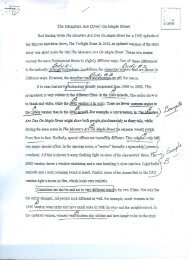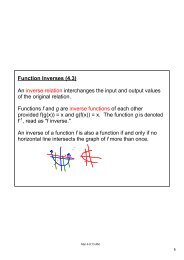REV Atomic and Nuclear
REV Atomic and Nuclear
REV Atomic and Nuclear
You also want an ePaper? Increase the reach of your titles
YUMPU automatically turns print PDFs into web optimized ePapers that Google loves.
<strong>Atomic</strong> Physics<br />
<strong>and</strong><br />
Quantum Effects<br />
A photon is a particle of light. It has no mass, but can<br />
transfer energy to <strong>and</strong> from electrons.<br />
To determine the energy of a photon: E = hf<br />
To determine the momentum of a photon: p = h<br />
λ<br />
To determine the wavelength of a photon:<br />
start with E = hf, then use v = fλ<br />
1
E = 0 eV<br />
E3 = 6 eV<br />
E2 = 7 eV<br />
E1 = 10 eV<br />
<strong>Atomic</strong> Energy Levels<br />
E1 is called the ground state<br />
E = 0 eV<br />
E3 = 6 eV<br />
E2 = 7 eV<br />
E1 = 10 eV<br />
Electrons in an atoms can have<br />
only certain amounts of<br />
energy. To move up levels an<br />
electron must absorb an exact<br />
amount of energy from a<br />
photon <strong>and</strong> to drop down an<br />
energy level, the electron emits<br />
a photon with a specific<br />
amount of energy.<br />
How can an electron get<br />
from the ground state to<br />
level 3?<br />
It could either absorb 4 eV<br />
from a single photon OR it<br />
could first absorb 3 eV from<br />
one photon <strong>and</strong> then 1 eV<br />
from a second photon.<br />
What if an electron absorbs 10 eV of energy? It leaves the<br />
atom. This is called ionization energy.<br />
2
The Photoelectric Effect<br />
Light energy striking a metal surface can cause the metal to<br />
eject one of its electrons, but only if the frequency of the<br />
incident light is above a certain value.<br />
The minimum frequency of light needed is called the cutoff<br />
frequency.<br />
The metal surface is described by its work function (φ).<br />
Work function (φ) is calculated by (φ) = hfo<br />
The Photoelectric Effect<br />
of the<br />
electrons<br />
KEmax = E φ<br />
Energy of the<br />
incident photons<br />
Work Function<br />
of the metal<br />
remember, Ephoton = hf <strong>and</strong> φ = hfo<br />
KEmax = hf hfo<br />
3
Stopping Potential<br />
KEmax = qVo<br />
if KEmax is expressed in eV, then stopping potential is that<br />
same value expressed in Volts <strong>and</strong> vice versa.<br />
From here, we can calculate the velocity of the ejected<br />
electrons: KEmax = 1/2mv 2<br />
mass of electron<br />
de Broglie Wavelength (Matter Waves)<br />
λ = h<br />
mv<br />
Compton Scattering<br />
Photons collide with electrons, transferring some energy<br />
to the electron, electron now has velocity (KE), photon<br />
loses energy, thus is wavelength is lengthened.<br />
4
Three Types of Subatomic Particles:<br />
(1) Alpha α 2 protons & 2 neutrons stuck together<br />
(2) Beta β + or β <br />
(3) Gamma γ a photon<br />
The Three Decay Processes:<br />
either + or electron<br />
(1) Alpha emits one alpha particle, mass number drops<br />
by 4, charge drops by 2<br />
4<br />
2α<br />
(2) Beta Decay either an electron or positron is emitted.<br />
No change in mass, charge either increases or<br />
decreases by 1.<br />
e + 0<br />
+1<br />
e 0<br />
1<br />
(3) Gamma a photon is emitted which results in no<br />
change in outward appearance. Emitted photon has KE,<br />
where did it come from? Change in mass during the<br />
decay process.<br />
5
15<br />
8 O decays via B + emission. Which of the<br />
following is the resulting nucleus?<br />
a)<br />
b)<br />
c)<br />
15<br />
9 F<br />
16<br />
8 O<br />
15<br />
7<br />
N<br />
d)<br />
e)<br />
16<br />
9<br />
16<br />
7 N<br />
F<br />
6
Identify the missing particle in the nuclear reaction below:<br />
13<br />
6 C + ( ? )<br />
a) electron<br />
b) proton<br />
c) deuteron<br />
d) positron<br />
e) gamma photon<br />
13<br />
7 N + n<br />
Mass Defect<br />
Think about each of the decay processes; in each process,<br />
a particle is ejected (really, really fast). The remaining<br />
nucleus has to recoil to conserve momentum. Now, both<br />
particles are moving. Originally, there was no KE, now<br />
there's a bunch. Where did it come from?<br />
Before the decay, there was more mass than after. During<br />
the decay some of the mass was converted into energy.<br />
E = Δmc 2<br />
7
from your h<strong>and</strong>out in class:<br />
10
















